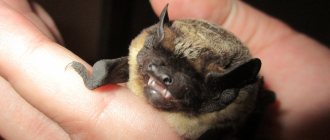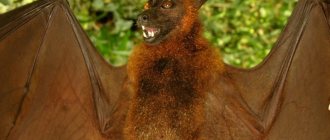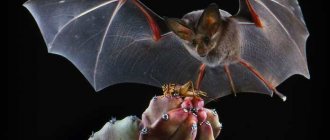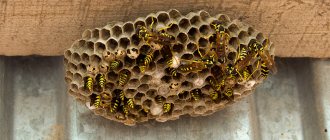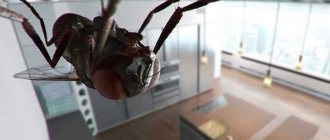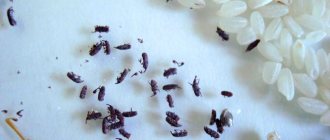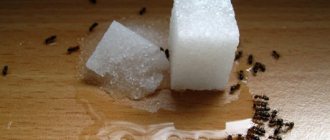These are fairly harmless creatures. The proximity to them frightens people, rather because of their “notoriety”, based on the Christian tradition, which attributes to them a connection with evil spirits.
In China, on the contrary, the bat symbolizes good luck and success. Even greeting cards and lottery tickets feature these night fliers. Interestingly, the words “bat” and “luck” are represented by the same hieroglyph.
In addition, most of them feed on insects, which brings undoubted benefits to agriculture. During the night, one individual eats a number of insects equal to half its own body weight.
What to do
According to local folk beliefs, the arrival of a night visitor is associated with a warning of misfortune. In China, the appearance of an animal is welcomed - it is believed that it signals good luck in business and an imminent improvement in the family’s financial situation. What does the visit of a winged guest mean from a biological point of view:
- young age - inexperienced mice, in the heat of excitement, miss and fly into open windows;
- migration time - the search for new secluded places brings them into houses and balconies.
Important! Bats fly into apartments by mistake, and not for bloodthirsty purposes. The lost guest needs help.
How to catch without a mousetrap
If a bat flew into the house through the ventilation, then catching it will not be difficult. A person should protect themselves as much as possible from accidental bites: wear thick gloves, a tracksuit or sweater to protect the skin.
Once in an unfamiliar room, the mouse begins to fly hysterically, trying to find a way out. She needs time to calm down and sit on some surface (including walls). Experts advise adhering to the following algorithm for driving away uninvited visitors:
- take an empty medium-sized box so that it covers the mouse along with its wings;
- cover a sitting animal with it;
- carefully insert the cardboard between the wall and the box;
- go out into the street or loggia and free the animal.
All actions are carried out as carefully as possible - so as not to damage the thin wings.
Important! In most countries, the destruction of bats is prohibited - they are listed in the Red Book and are protected by law.
How to drive a bat out of an apartment at night
When unexpected guests appear, there is no need to make noise trying to catch them. Zoologists recommend the following scheme:
- ask all household members to leave the room;
- open the window;
- turn off all lighting sources - chandeliers, night lights;
- go out and close the doors tightly behind you.
After half an hour, look into the room - in 99% of cases, the bat will leave its confines on its own. Otherwise, you can catch a thrashing animal with a thick towel or a net. The main thing when fishing is not to let yourself be bitten or scratched.
Folk remedies
Homemade recipes are suitable for those who have encountered a whole colony of animals that have chosen an attic or technical floor in a multi-story building for permanent residence. Permanent residence creates a number of inconveniences: the animals rustle loudly, squeak and squeak their claws on wooden and metal surfaces.
To get rid of constant fuss, you can try several means of expulsion:
- Mothballs - rodents and bats cannot tolerate the aroma emanating from it. Tablets or bags of powder are placed in habitats - near nests or large amounts of droppings. An unpleasant smell will prevent old and new colonies from flying into the attic and establishing a nesting place in it.
- Aromatherapy - special incense sticks or essential oils work no worse than naphthalene. The animals have a negative attitude towards the smell of chamomile, peppermint, and common tansy. Wormwood, dog's tongue, wild rosemary and elderberry roots also repel uninvited guests.
- Loud sounds - heavy rock, turned on for several hours, will give the winged creatures a good shake-up and force them to look for another place to live.
- The sources of noise (you can buy ready-made ones or make them yourself) are a weather vane, Chinese “wind music” or the thinnest metal plates hung close to each other creating a cacophony that is unpleasant for their sensitive hearing.
- Light - bright lighting fixtures simulating daylight and placed around the perimeter of the attic will cause panic among bats. Using lanterns for several nights in a row will drive impostors out of your home.
- Closing the entrances - you need to find all the cracks through which mice enter the home and cover them with polyurethane foam. The procedure is carried out at the moment when the inhabitants have flown away to hunt or have been frightened away from their nests by loud sounds and light.
- Fear - in the daytime, one animal is carefully caught and placed in a box with drilled holes. With the onset of darkness, it will begin to scream, trying to get out and warning its relatives of the danger. The flock will react to its fellow tribesman and leave the den in full force. After they leave, the prisoner is taken outside and released.
Important! Experts recommend using a smoker - bats cannot stand its smell. Before carrying out an action to evacuate uninvited guests, you need to warn your neighbors: vigilant citizens, seeing a smoke screen, can call the Ministry of Emergency Situations.
Means for getting rid of flying pests
There are many methods that can help you get rid of bats in your attic. Each option has pros and cons.
When choosing products, they rely on their ease of use, the number of mice living in the attic or barn, and the price.
Sealing cracks with boards or foam
The most effective way to prevent bats from appearing in the attic again is to wall up the passage into the pests' home. Sealing the nest involves the use of boards, or blowing out cracks and exits using polyurethane foam. It is important to ensure that there is no family. After all, if the mice remaining inside the nest die, the process of rotting of the individuals will begin, and a fetid aroma will appear.
Smoking with a smoker
In order to get rid of bats under the roof of a house or country house, they use the smoking method. A smoker is well suited for this. It is recommended not to overdo it with the smoker. Mice are smoked for 2-3 days as they get used to the home. This type of control is questionable, since the smoke dissipates and the mice may return again.
Important! For people, this folk method is not harmless.
Hose with water
Another folk remedy is water. Animals don't like water, so giving them a cold shower with a hose will help get rid of the flying family. This procedure is carried out several times, because the mice may return.
Advice! Before using this method, you need to make sure that water does not flood the ceiling of the house.
Special sprays
Special stores sell aerosols and sprays that are used to remove mammals.
Important! Observations by researchers have shown that the use of some drugs is low in effectiveness.
Important! Sprays containing toxic elements should not be used in the fight against animals. They can harm people and pets.
Repellent sprays are carried out as follows. In the evening, when the bats leave their home, the product is sprayed. Upon returning, they will not like the smell, and the animals will fly away in search of a new suitable place.
In the fight against mammals, use the 876 4-Pack Bat Repellent spray. The drug contains peppermint. Sprays are recommended for spraying in animal nesting areas. After such treatment, the bats fly away from their home forever.
Ultrasonic repellers
The best devices for removing rodents from roofs and balconies are repellers equipped with ultrasound. A device that emits ultrasound waves repels critters from the attic and prevents them from returning.
Repellers are easy to use. All you need to do is follow a few steps:
- The device is plugged in; the operating mode is selected; after 2 weeks the pests will disappear completely.
Important! The device operates on the principle of emitting sound waves. Their frequency: 35-60 kHz. The human ear canal does not detect such sounds, therefore the device is safe if the power does not exceed 130 dB. But this frequency has a negative effect on animals.
The advantages of ultrasonic repellers include:
- silent operation; safety for people; economical; no auxiliary settings required.
Important information! The effectiveness of an ultrasonic device depends on the correct location and quantity, taking into account the power and radius of influence.
Mothball bags
You can get rid of a bat using mothballs. For this:
- mothballs in an amount of 250 ml are laid out on a small piece of gauze; a bag is formed from the gauze; the bag must be tied to the habitat of the animals when they are absent. The aroma emitted by mothballs will prevent them from returning to the nest.
Attention! It is possible to repeat the manipulation more than once. You will need to check on the rodents from time to time, changing bags that have lost their aroma. But the result will be relief from pests.
Mothballs are harmful to the health of people and pets. You should be careful when using them.
Fans
An environmentally friendly and harmless option to drive out flying individuals is a fan. He is sent straight to the mouse family. The disadvantage of this product is the high consumption of electricity and noise from equipment that must operate for a long time.
Bright lighting
Bats do not perceive bright light. If you shine light in advance into areas that are potential overnight stays for animals, you can actually eliminate them. Chiropterans will not fly to illuminated places. The disadvantage of this method is high energy consumption and low percentage efficiency.
Loud music
It is believed that loud music will scare away the bat. You can use this option for scaring, but the effectiveness of this folk method has not been proven.
Calling special teams
If the above methods do not solve the problem with flying individuals, then the only quick option for removing mice is to call a special sanitary service. SES workers have modern drugs and equipment.
How dangerous are pests and diseases?
Contact with bats can lead to serious viral and fungal diseases. A frightened animal, when picked up, bites, along with saliva, transmitting bacteria and viruses directly into the blood of the offender.
The most dangerous pathologies that can be transmitted to humans include:
- Rabies is an incurable disease that requires an immediate visit to the hospital for vaccination. It begins with changes in behavior, unreasonable aggressiveness, anxiety, and headache attacks. As it progresses, the person develops dehydration, paralysis, and death.
- Darling's disease is transmitted by inhalation of spores that rise into the air when moving through the feces of animals. The symptoms of the disease can easily be confused with the flu; the only difference is the absence of fever.
Bats carry many diseases that are fatal to humans. Depending on the area of residence, they are capable of transmitting Ebola, Marburg, Hendra fever, and SARS.
Important! A bite from an animal that collides with a person requires immediate medical attention. The victim will have to undergo a course of rabies vaccinations to prevent rabies infection.
Neighborhood dangers
The unpleasant coexistence with the bat colony is due to the interference it creates. People who are faced with the unauthorized colonization of bats make complaints:
- to constant noise - night activity and fussing interferes with sleep, scares children;
- unpleasant odors and dirt - waste products are scattered under permanent habitats, emitting a disgusting aroma;
- unsanitary conditions - animals are carriers of infections and viruses, including those dangerous to humans; their droppings contain many pathogens and parasites;
- roof damage - animals gnaw holes in the insulation and waterproofing of the insulation; their activity requires constant repair of the roof.
The main danger when encountering blood-sucking bats is bites. Automatic protective reflexes of animals lead to infection of people; in Russia, between May and September, they spread rabies. In other species of animals, problems are caused by droppings, as the main transmitter of fungal infections.
Important! Epidemiologists advise cleaning rooms from traces of bats' activity using gloves and a respirator. After treatment, all clothing is disinfected and thoroughly ironed.
Favorite places to live
Before getting rid of bats, it is necessary to locate all their habitats. Chiropterans prefer to settle in dry rooms, with a large number of protrusions to which they cling and hang upside down:
- in multi-storey buildings they prefer attics and technical floors;
- in apartments, animals nest in the ventilation system or on the loggia;
- in rural areas, encounters with unwanted guests occur more often: wooden structures and poor insulation allow them to be located in chicken coops, cowsheds, outbuildings, and under the roof of residential buildings.
Important! The exact location of the nests is determined by piles of droppings: dark brown interspersed with shiny dots (insect shells). It is impossible to confuse it with the excrement of other animals, including rats and field mice.
Prevention
To prevent the infestation of bats, simple rules must be followed. Experts focus on the following points:
- space under the roof - even small cracks can serve as an entrance for the compact bodies of animals;
- air ducts and ventilation systems are covered with thin meshes or grilles blocking the passage;
- in areas of possible settlement, hang foil, tins - anything that creates noise during air circulation;
- lighting - animals do not like places where sunlight freely penetrates.
It is better not to use chemicals in aerosols or baits - most bats are protected by law, and their destruction will lead to large fines. You can find out about permitted methods at your local sanitary and epidemiological station. If there are no results in expelling a flock of bats on your own, you can apply for a team specializing in this issue.
The best season for clearing your home of animals is autumn. In winter they hibernate, and in spring and summer they reproduce. Colonies consist of females raising their young. Attempts to breed mice at this time will lead to the death of the young.
I’ve been living alone in a rented apartment for 8 months, now I’m sitting in the living room working on my laptop, suddenly I hear some rustling in the corridor, I think about the bags that I recently folded, and then suddenly something starts flying in the corridor, while I was wondering what it was , I thought I would turn gray. (small bat. In winter. Where from. We managed to push her out onto the balcony, thank God. But then immediately some thoughts about mysticism ((how could she get into the apartment (the balcony practically does not open)
21.09.2019
Bats cause panic in many people, so if they appear in a house, attic or apartment, residents need to remain calm. Despite the terrifying appearance of the animal, it does not pose much danger to humans. Once a bat has flown into your home, you need to follow a few simple recommendations to help get rid of it. More often they arrive by accident, at night they fly into the light from windows and other places. In an apartment, laundry that is drying can become a beacon.
Preventive measures
After expelling the bats from under the roof, the attic must be cleaned, destroying all traces of their presence, and also disinfected. Protrusions and holes in the roof can cause bats to re-invade. To prevent them from returning, you can use the following recommendations:
- seal the cracks, repair the roof, or cover it, plaster the attic. Even a small hole can cause a problem, since the animal’s body is small; occupation can be prevented by using nets and gratings that block the entrance of pests, without interfering with air circulation in the attic; conduct a systematic inspection of roofs and technical buildings for the presence of rodents and their excrement; Effectively, the methods used must be repeated several times, paying attention to the nests; close windows and doors tightly.
The procedure for destroying a bat is not easy. It requires perseverance and patience from the owners of dachas, sheds, and houses. A suitable method for removing chiropterans will not only clear the space, but also prevent the emergence of mammals in the future. Source
Why do bats fly into the house?
A bat can fly into a private house or apartment onto the balcony by mistake and by accident. This often happens if the animal is small, young and inexperienced. The main time of entry into residential areas is early autumn and mid-summer. They can fly in during migration. At this time, bats are not very picky when choosing a shelter.
In winter, exposure may be due to weakness of the animal or in the case of the loss of small bats by their parents. The reasons are many and varied, but you need to immediately understand that there is nothing terrible, the main thing is to find bats in the apartment, if they are hidden, and try to carefully remove a family or one individual.
Interesting! Bats are the only mammals that can fly.
Reasons for appearance
In nature, to create places for their settlement, bats choose dry, dark, high-altitude places, natural depressions - caves, hollows, etc.
Human dwellings, firstly, attract bats with high altitude - this is the reason for the sudden appearance of bats in the attics of residential high-rise buildings, balconies, etc.
Private houses are also tempting - bats choose non-residential premises and spaces because they are dark, dry and quiet - attics of houses, barns, chimneys, etc.
In nature, bats tend to lead an active lifestyle from spring to autumn. Then, the animals either fly away to warm countries or hibernate.
But, since a person’s home is, first of all, an approximately constant temperature, this is exactly what they like, and bats on the roof of a house can continue to remain, multiplying their offspring, without changing place.
That is, they appear in our houses and on roofs only because they are looking for a reliable place for breeding offspring and further life.
And, it should be remembered that they arrive in whole colonies at once, and not in separate “pairs”.
What danger do they pose?
The main mistake homeowners make when a bat gets into their apartment is panic. You should not do this; the creature may become frightened and begin to make a loud squeak, causing discomfort to everyone. Although the animal is considered safe for humans, there are some risks:
- A bat may bite if you try to grab it. For protection, you need to use gloves. Animal droppings are very dangerous, because they are infected with histoplasmosis. As a result of the action of the fungus, a person can develop serious respiratory tract diseases. It enters the body by airborne droplets, through vapors coming out of feces. Spores become airborne if you step on them after drying. To protect against harmful effects, you can simply remove the droppings. If bats live in a colony in the attic and leave feces, then you must use a respirator during your work. The worst danger to humans is the possibility of contracting rabies. Bats carry the disease without visible signs. The creatures are at peace, without aggression, but exceptions are possible. Sick bats attack anything that moves. Their life expectancy in captivity is no more than five days. In some cases, people become infected while helping an exhausted animal that is on the ground, without using gloves or other protective equipment.
Bats can be dangerous not only to people, but also to pets. Therefore, it is important to promptly determine the presence of creatures in the house and take measures to remove them.
How to make sure that they have settled in the apartment
Bats appear at the dacha, in an apartment or other premises in whole colonies or singly, flying in due to inexperience. Loners more often end up on the first floors, and it is impossible to get rid of them without using special methods. They are just starting to fly, so they are unlikely to get out on their own.
First of all, you need to make sure that the bat has settled on the balcony in the apartment or other rooms. Initially, you need to remove the pets and take out all your things.
Squeaking and grinding of claws
Effective removal of bats is possible after searching for them in an apartment or house. More often they settle in attics, in wall cracks, on balconies or ventilation systems. Occupancy can be determined by the squeaking of mice and the grinding of their claws on the walls of the shelter.
Presence of droppings in the form of dark powder
The main sign by which the presence of an animal can be determined is the appearance of feces. Visually, it resembles a dark-colored powder; on the surface of the floor or other elements you can see the shine from the shells of insects that are in the feces. It is difficult to immediately find droppings, so bats can only be identified using other methods.
Determine where the mouse flies out to hunt
Using this feature, it is not difficult to determine the presence of bats. It is necessary to wait for darkness to track where the creatures fly out from to hunt. Once a shelter has been found, the homeowner needs to monitor exactly when the bats constantly leave it. If this is not done, then when sealing the cracks there is a risk of cementing the animal, which after death will decompose, creating a fetid odor. To do the work correctly, you need to understand that the creature is out hunting. An animal can have many exits; it is important to check all possible holes and cracks.
Attention! Among bats there are 3 types of vampires, but they live in the tropics and subtropical parts of the USA, consuming the blood of livestock, less often of people.
Features of bats
Bats belong to the order Chiroptera. But they are not “relatives” of ordinary mice. They are considered primates. These animals are nocturnal, despite their rather poor eyesight, and are perfectly oriented in the dark. Bats emit ultrasound, which helps to accurately distinguish small stones from insects over long distances. It is thanks to echolocation that they move in the dark. Below are some more interesting facts about bats.
- Life cycle. Bats live longer than dogs. On average, the lifespan of a “mystical” animal is 25-30 years.
- Dimensions. Bats, depending on the species, may have different parameters. Some individuals do not exceed the dimensions of a bumblebee in size. But there are also real giants, whose wingspan is 2 m.
- Ancient inhabitants. According to archaeological excavations, bats inhabited our planet approximately 55 million years ago. These animals have been practically untouched by evolution. Their remains are no different from modern individuals.
- Body temperature. Can vary from −7ºС to +48ºС.
- State of numbness. In winter, bats, deprived of the opportunity to get their own food, prefer to do nothing. Goes into a sleep state. This numbness can last up to eight months. The animal independently slows down metabolic processes and lowers body temperature. In the event of severe frosts, they can turn into real “icicles”, but with the arrival of warmth they thaw and continue their life activity again.
Bats breed once a year. Babies are conceived during wintering. The offspring are never numerous. Usually in the summer only one mouse is born. Sometimes two cubs may be born.
Area
These animals choose secluded, dark and completely safe shelters during the daytime. In the wild, they settle in rock crevices, caves, abandoned burrows and hollows, on the slopes of dunes, even in the recesses of walls.
Human activity is leading to the destruction of natural bat habitats. The animals are forced to look for new shelters. They quickly adapt to the new environment and settle next to humans. The winged ones inhabit abandoned adits and mines, attics, cellars, cellars and forgotten bell towers. Uninvited guests can be found in haystacks and on balconies.
Bats are unable to take off from the ground because they have rather large wings. Therefore, they choose places to rest from which they can throw themselves headfirst.
Nutrition and main types
Despite the vampirism attributed to them, most species are quite peaceful and vegetarians. However, not all. Food preferences depend on the type of mouse. More detailed information is provided in the table.
Table - Types of bats
Species nameDescriptionWhat they eat
| White (tailless) | — They have a length of up to 4.5 cm, small ears and an unusual nose; — live in Honduras, Panama, Costa Rica, Nicaragua; — settle in the huge leaves of heliconia, forming a family of 5-6 individuals | Fruits |
| Vechernitsy | — Inhabit North Africa and European countries; - have large sizes (length 10-50 cm); — fly at a speed of 60 km/h; - live in deciduous forests | — Beetles; - butterflies; - small songbirds |
| Fruit (dogs or foxes) | — Live in the forests of Malaysia, the Philippines, Laos, Vietnam; - distinguished by an elongated muzzle; - the body reaches 42 cm, and the wingspan is 1.7-2 m; - settle in trees; - live in huge colonies | - Bananas; - papaya; - grapes; - coconuts |
| Smooth-nosed | - They have a smooth muzzle without any cartilaginous growths; - found in all countries where woody vegetation grows | — Insects; - fish |
| Ushany | - They have large ears; - distinguished by short and wide wings; - the body reaches a length of 5-6 cm; - found in Europe, Asia, North Africa | — Beetles; - butterflies; - mosquitoes |
| Horseshoe bats | - They have a cartilaginous growth in the area of the nose that resembles a horseshoe; — take off immediately after sunset; - hunt only in the first half of the night; - live in the Caucasus | Insects |
| Nightwomen | — Inhabit all countries and continents, except the Arctic; - fly out to hunt in complete darkness; - have a high degree of adaptability, can live in any conditions; - fly calmly and slowly | By night insects |
| Vampire | - They have weak echolocation; - have developed hearing; - have infrared receptors; - inhabit only South and Central America | Blood of birds and animals (sometimes they can drink blood from a sleeping or exhausted person) |
Methods for controlling bats in a house or apartment
Before learning all the ways to help remove bats from your home, it is important to try to catch the animal. Experts make several recommendations:
- Children and animals must be taken to another room. Open the windows on the balcony or in other rooms, turning on the lights. Leave the space for a while so that the chiropteran animal calms down and flies out on its own. The mammalian creature can continue to fly in the house, so you need to wait until it gets tired and lands on the floor or other flat surfaces. Do not knock it down with a broom or mop, as it can cause serious damage. You need to put gloves on your hands, take a cardboard box and slowly cover the bat. After a few minutes she will calm down, put cardboard under the bottom, hold the structure and turn the box over. In the summer, you can let the animal outside, preferably at night; during the rest of the year, it is better to transport the animal to the veterinarian.
Night guest
A dark, spacious apartment in a high-rise building in the north of Moscow. Nearby are the Northern River Station and the black expanse of the Khimki Reservoir. It's only nine in the evening, but for October it's already night. There are two of us at home - me and my cat Girard.
- Bzhzhzh, boom. Bzhzhzh, boom. Buzzing and the sound of hitting the wall in the kitchen. Apparently a bumblebee flew in, strange. The cat is right there, hunting. I quickly go to my room, where the light is on. The buzzing turned into flapping wings - phhh, phhhh, phhhh. Butterfly? In October?!
The butterfly is no longer there. A bird is flying around the room. From the light of the chandelier, winged shadows stretched half a meter across the ceiling. No, it's not a bird. The creature is larger than a sparrow, but smaller than a dove. Girard bares his fangs and meows. It taps its tail on the floor so hard that blows can be heard. Starts jumping after this creature. This is a bat...
Once - and she stuck to the door, wrapping her wings around it from above. Silence.
After the hunt. Girard studies fishing gear. Photo: portal Moscow 24/Ivan Nosatov
I find myself on the balcony with a notebook in my hand, the door is closed. Breathing is rapid. From afar, I took a video of the night visitor on my phone. “Batman flew into my house!” – emotions were overwhelming, and I was talking complete nonsense. Having calmed down a little, I threw a blanket over the mouse and released it into the Moscow night. She squealed loudly on her way to the balcony. She was scared...
Moscow courtyard in the Levoberezhny district, where the bat was released. Photo: portal Moscow 24/Ivan Nosatov


